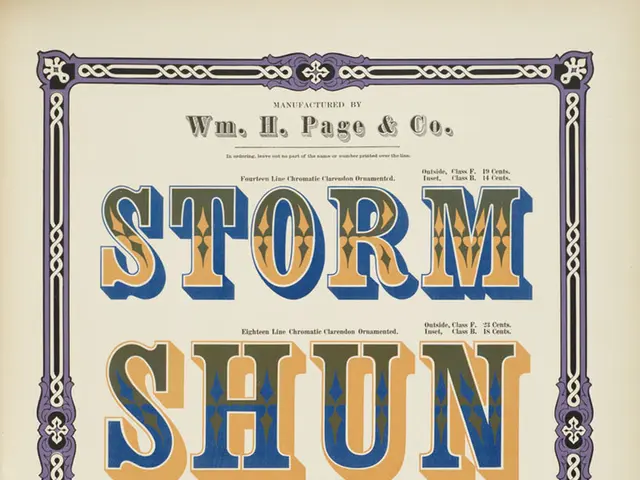Profiting from your passion for books: Strategies for earning income as a bibliophile
Hey there, book lover! Ever thought about turning your passion for books into some extra cash? Welcome to the world of selling digital products online! This isn't a get-rich-quick scheme or an MLM, but a practical guide on how to sell educational digital products that align with your love for literature.
What are Digital Products and How to Make Money with Them?
Digital products are files or online resources that can be sold as downloads or accessed after purchase. Think ebooks, Google Doc templates, video workshops, printable worksheets, and digital planners. You can selling just about anything that your customers can use online, on their tablets or print out!
I sell my products on Etsy, but you can also use other platforms like PayHip, ThriveCart, SendOwl, or Shopify if you have your own website. Etsy brings about half of my traffic, while I generate the other half through my blog and social media.
My Journey Selling Digital Products
I have my Etsy shop, Writer Lifestyle, and most of my income comes from it because it's a marketplace that attracts tons of daily visitors. If you have a big social media following, you could direct all that traffic to your own website without the risk of losing business to other shops on Etsy.
My products are primarily about writing fiction, but I also offer a few for readers, book clubs, and even a couple for business. I create new products regularly and update or retire older ones.
Last February was my best month, making almost as much as I would have in a terrible nursing job, giving me the freedom to ditch that career.
Common Myths About Selling Digital Products
A common argument is that if I were making money, I wouldn't be teaching people how to do it. But think about it—if you're good at something, why wouldn't you share it with others to make money from it too? Plus, I genuinely enjoy teaching!
I'm aware that there are scam artists out there exploiting the digital product market, but my tips are based on my successful experience and current business performance. If you come across someone selling cheap POD products or promoting AI to make tons of money, be skeptical. Always go with someone who has proven results and is currently seeing success[1][2].
Ideas for Bookworm Digital Products
Interested in creating digital products that cater to book lovers? Here are some ideas:
- Educational products, such as printable literary analyses, study guides, or worksheets related to favorite books or authors.
- Entertainment products, like reading bingo cards, printable book club discussion questions, or book-themed crosswords.
Potential products include:
- A printable To-Be-Read list for the Kindle Store.
- Academia-inspired habit trackers for reading goals.
- Google Doc lecture templates for literature classes.
- Printable reference sheets for poetic meters.
- Book review templates with prompts.
- Post ideas for Bookstagram or Booktok accounts.
- Reading challenge checklist for Excel[1].
Enrichment Data:
Creating and selling educational digital products for book lovers involves several key steps. Here’s a structured approach to help you launch your product successfully:
1. Identify Your Niche and Product Idea
Narrow Your Focus:
The “book lover” niche is broad. Focus on specific interests, such as literary analyses, book club guides, reading challenges, or author studies. Consider what gaps exist—like printable reading trackers, book review templates, or guides to classic literature[2][3].
Brainstorm Product Ideas:
Ask yourself:- What do book lovers ask for help with?- What tools would help them read more, analyze literature, or connect with others?- What digital resources would you find useful as a book enthusiast?[2][3]
Potential product ideas:- Ebooks or PDF guides on literary themes, author biographies, or how to start a book club.- Printable reading journals or trackers for tracking books read, favorite quotes, or reading goals.- Online mini-courses on reading strategies, book analysis, or writing book reviews.- Book club discussion templates and worksheets[3].
2. Create Your Digital Product
Outline and Develop:
If you’re creating an ebook or guide, outline the content, write it, and design it with tools like Canva, Google Docs, or Adobe InDesign. For courses, prepare video lessons, slides, quizzes, or downloadable resources.
Use Technology:
Leverage AI tools (like ChatGPT) for brainstorming, structuring your guide, or writing drafts. AI can help you generate ideas, check for market demand, and even assist with content creation[2][4].
Format for Scalability:
Start with a simple product (like an ebook or printable), then expand to courses, coaching, or community events as your audience grows[2][3].
3. Set Up Your Digital Store
Choose a Platform:
Select a platform to host and sell your digital products. Popular options include:- Shopify for standalone digital stores.- LearnWorlds for courses and downloads (offers templates and marketing support).- Etsy or Gumroad for downloadable files and printables[1][3].
Customize Your Store:
Ensure your store is visually appealing and easy to navigate. Add clear product descriptions, previews, and testimonials if available[1][3].
4. Promote Your Digital Products
Build an Audience:
Start with your existing network—friends, book club members, or social media followers. Share your product on platforms like Instagram, Pinterest, YouTube, or Facebook Groups[2][5].
Content Marketing:
Create blog posts, videos, or social media content about your niche. Share tips, book recommendations, or behind-the-scenes looks at your creative process to attract book lovers[1][5].
Collaborate:
Partner with book bloggers, influencers, or other creators in the literary space. Offer free samples or exclusive discounts in exchange for reviews or promotions[3][5].
5. Launch and Iterate
Launch Your Product:
Announce your product via email, social media, or live events. Offer a limited-time discount or bonus to encourage early adoption[3].
Gather Feedback:
Ask for reviews and feedback from early customers. Use this input to improve your products or create new ones[2][3].
Expand Your Offerings:
Once you’ve established your first product, consider adding new formats (courses, printables, workshops) or deeper content within your niche[2][3].
[1] Source: The Home Winger[2] Source: Penny Hoarder[3] Source: BookNook[4] Source: Drip
- Embrace creative writing and compile a collection of ebooks or PDF guides about literary themes, author biographies, book club strategies, or writing book reviews – these can be sold as digital products online.
- Create engaging educational products for book enthusiasts, such as printable literary analyses, study guides, or worksheets related to favorite books or authors.
- Design interactive entertainment products like reading bingo cards, book club discussion questions, or book-themed crosswords to cater to book lovers' interests.
- Sell your products through online learning platforms like LearnWorlds, Etsy, or Gumroad, ensuring that your store is visually appealing and easy to navigate.
- Market your digital products effectively by creating content around your niche, collaborating with book bloggers and influencers, and offering promotions or exclusive discounts to build an audience and drive sales.








